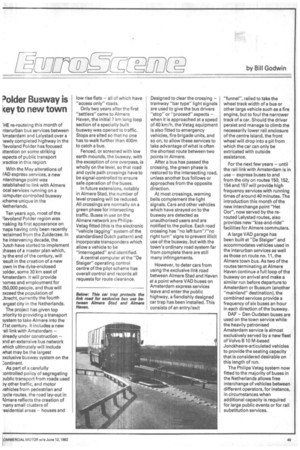Polder Busway is key to new town
Page 43

If you've noticed an error in this article please click here to report it so we can fix it.
'HE re-routeing this month of nterurban bus services between \msterdam and Lelystad over a aewly completed highway in the levoland Polder has focused attention on some striking aspects of public transport aractice in this region.
With the May alterations of /AD express services, a new nterchange point was astablished to link with Almere ocal services running on a ;omputer-controlled busway acheme unique in the Vetherlands.
Ten years ago, most of the levoland Polder region was naking its first appearance on naps having only been recently .eclaimed from the Zuiderzee. In he intervening decade, the )utch have started to implement atlases of a master plan which, ay the end of the century, will .esult in the creation of a new :own in the dyke-enclosed adder, some 30 km east of kmsterdarn. It will provide lomes and employment for 250,000 people, and thus will axceed the population of
Jtrecht, currently the fourth argest city in the Netherlands.
The project has given top Driority to providing a transport aystem to take Almere into the 21st century. It includes a new -ail link with Amsterdam — already under construction — and an extensive bus network ryhich ultimately will include ovhat may be the largest axclusive busway system on the :ontinent.
As part of a carefully
;ontrolled policy of segregating public transport from roads used ay other traffic, and motor rehicles from pedestrian and ;ycle routes, the road lay-out in 4Imere reflects the creation of rany small clusters of -esidential areas — houses and
low rise flats — all of which have "access only" roads.
Only two years after the first "settlers" came to Al mere Haven, the initial 7 km long loop section of a specially built busway was opened to traffic. Stops are sited so that no one has to walk further than 400m to catch a bus.
Fenced, or screened with low earth mounds, the busway, with the exception of one overpass, is wholly on the level, so that road and cycle path crossings have to be signal-controlled to ensure safe operation of the buses.
In future extensions, notably in Almere Stad, the number of level crossing will be reduced. All crossings are normally on a green phase for intersecting traffic. Buses in use on the Almere network are PhilipsVetag fitted (this is the electronic "vehicle tagging" system of the standardised Dutch pattern) and incorporate transponders which allow a vehicle to be "interrogated" and identified.
A central computer at the "De Steiger" operating control centre of the pilot scheme has overall control and records all requests for route clearance. Designed to clear the crossing — tramway "bar type" light signals are used to give the bus drivers "stop" or "proceed" aspects — when it is approached at a speed of 40 km/h, the Vetag equipment is also fitted to emergency vehicles, fire brigade units, and so on, to allow these services to take advantage of what is often the shortest route between two points in Almere.
After a bus has passed the crossing, the green phase is restored to the intersecting road, unless another bus follows or approaches from the opposite direction.
At most crossings, warning .bells complement the light signals. Cars and other vehicles which have strayed onto the busway are detected as unauthorised users and are notified to the police. Each road crossing has "no left turn"/"no right turn" signs to prevent illicit use of the busway, but with the town's ordinary road system far from complete there are still many infringements.
However, to deter cars from using the exclusive link road between Almere Stad and Haven at a point where VAD buses on Amsterdam express services leave and enter the public highway, a fiendishly designed car trap has been installed. This consists of an entry/exit "funnel", railed to take the wheel track width of a bus or other large vehicle such as a fire engine, but to foul the narrower track of a car. Should the driver persist and manage to climb the necessarily lower rail enclosure of the centre island, the front wheel will drop into a pit from which the car can only be extricated with outside assistance.
For the next few years — until the rail link with Amsterdam is in use — express buses to and from the city on routes 150,152, 154 and 157 will provide high frequency services with running times of around 40 minutes. The introduction this month of the new interchange point "Het Oor", now served by the rerouted Lelystad routes, also provides new "kiss-and-ride" facilities for Almere commuters.
A large VAD garage has been built at "De Steiger" and accommodates vehicles used in the interurban services as well as those on route no. 11, the Almere town bus. As two of the routes terminating at Almere Haven continue a full loop of the busway on arrival and make a similar run before departure to Amsterdam or Bussum (another "mainland" destination), the combined services provide a frequency of six buses an hour in each direction of the busway.
DAF — Den Oudsten buses are used on the town service while the heavily patronised Amsterdam service is almost exclusively served by a new fleet of Volvo B 10 M-based Jonckhee re-articulated vehicles to provide the seating capacity that is considered desirable on this length of run.
The Philips Vetag system now fitted to the majority of buses in the Netherlands allows free interchange of vehicles between different operators, for instance, in circumstances when additional capacity is required for large public events or for rail substitution services.






















































